Sentinel-1 Data for Winter Wheat Phenology Monitoring and Mapping
Abstract
:1. Introduction
2. Material and Methods
2.1. Study Site
2.2. Remote Sensing Data
2.2.1. Optical Data
2.2.2. Sentinel-1 Data
2.2.3. Gaussian Decomposition of SAR Temporal Profiles
2.3. In Situ Observations (Reference Plots)
2.4. Meteorological Data
2.5. Software Employed and Statistical Analysis
2.6. Methodological Approach
3. Results
3.1. NDVI Temporal Profiles
3.2. Sentinel-1 Temporal Profiles
3.2.1. Optimal S1 Configuration for Mapping the Three Phenological phases (Germination, Heading and Soft dough)
3.2.2. Optimal S1 Configuration for Mapping Harvesting (West and North Bekaa)
3.3. Smoothing and Gaussian Fitting
3.4. Germination, Heading, Soft Dough, and Harvesting Mapping
3.4.1. Accuracy Assessment and Quantitative Analysis
3.5. Toward Near-Real Time Phenology Monitoring
4. Discussion
4.1. S1 Versus NDVI Temporal Behavior
4.2. Influence of S1 Incidence Angle
- (1)
- In VV polarization: From the start of jointing till heading (84 DAS until 144 DAS), the decrease in the signal at 32–34° incidence angle was steeper and sharper than at the higher incidence angle (43–45°) because at high incidence angle, in addition to the attenuation, there is the smaller direct vegetation contribution [85]. In addition, at 40° of incidence angle and beyond, the direct vegetation volume scattering appears [84]. From 144 DAS until 186 DAS (soft dough), the signal increased at the two incidence angles. However, at soft dough phase (186 DAS), different behaviors were significantly recorded among the two ranges of incidence angles. On this date (186 DAS), the backscatter at 43–45° was slightly higher than that at 32–34° (Figure 4a,d) by around 1.5 dB, meaning that at the soft dough phase, at the 43–45° incidence angle, the signal held more canopy contribution than the radar signal did at lower incidence angle (32–34°). Such a behavior can be explained by the fact that after heading had occurred, the soil contribution, which was a dominant backscattering mechanism was considerably reduced and the canopy backscatter became more significant (at 43–45°). This finding is noted by different previous studies [82,83,84,85]. At harvest, the two incidence angles showed similar σ°.
- (2)
- In VH polarization: As wheat canopies reached heading phase, the S1 backscatter at high incidence angle reached lower levels than at low incidence angle (Figure 4b,e). This showed a sharper increase of the S1 signal from heading to soft dough at high incidence angle than at low incidence angle. This is the reason why mapping this phase (soft dough) using high incidence angle (43–45°) was more appropriate. Hence, as stated before (Section 3.3), the VH polarization has been seen as a better configuration through the analysis of the S1 temporal profiles for estimating the soft dough date. However, for easier operational application, VH polarization at low incidence angle (32–34°) could still be used. Nevertheless, when VH at 32–34° was used to map the soft dough phase, the soft dough could not be detected for around 10% of the wheat plots. In addition, the detection of the soft dough phase using 32–34° showed that for about 18% of the wheat plots, a different soft dough date estimation was observed of at least 6 days, in comparison to the one estimated at high incidence angle.
- (3)
- In VV/VH ratio: The steady mild decrease from sowing to heading in the ratio VV/VH (dB), which was seen at the two incidence angles (32–34° and 43–45), is mainly related to the slight increase in the VH (mainly from sowing till the beginning of March). The VH backscatter is dominated by the volume scattering mechanisms, increased as reported previously [55,80,81] while however, the VV backscatter, which is dominated by the direct contribution from the ground and the canopy decreased because of the rising attenuation from the predominantly vertical structure of the wheat stems [82], especially from March (96 DAS) through heading, during the stem elongation. From heading to soft dough phase, the ratio (VV/VH) was more or less constant at the two incidence angles (32–34° and 43–45°) as the signal in both VV and VH equally increased throughout this period as explained before (Section 3.3). From soft dough to harvesting, VV/VH (dB) at low incidence angle had shown a more significant dynamics than at high incidence angle. Thus, harvesting was observed when VV/VH (dB) at low incidence angle increased to reach the maximum.
4.3. Wheat Phenology Mapping
Quality Indicator, Strengths, and Perspectives
5. Conclusions
Author Contributions
Funding
Acknowledgments
Conflicts of Interest
References
- Fieuzal, R.; Baup, F.; Marais-Sicre, C. Monitoring Wheat and Rapeseed by Using Synchronous Optical and Radar Satellite Data—From Temporal Signatures to Crop Parameters Estimation. Adv. Remote Sens. 2013, 2, 162–180. [Google Scholar] [CrossRef]
- Baghdadi, N.; Boyer, N.; Todoroff, P.; El Hajj, M.; Bégué, A. Potential of SAR sensors TerraSAR-X, ASAR/ENVISAT and PALSAR/ALOS for monitoring sugarcane crops on Reunion Island. Remote Sens. Environ. 2009, 113, 1724–1738. [Google Scholar] [CrossRef]
- Mandal, D.; Kumar, V.; Rao, Y.S.; Bhattacharya, A.; Bera, S.; Nanda, M.K. Combined Analysis of Radarsat-2 Sar and Sentinel-2 Optical Data for Improved Monitoring of Tuber Initiation Stage of Potato. ISPRS Int. Arch. Photogramm. Remote Sens. Spat. Inf. Sci. 2018, XLII–5, 275–279. [Google Scholar] [CrossRef]
- Stockle, C.O.; Donatelli, M.; Nelson, R. CropSyst, a cropping systems simulation model. Eur. J. Agron. 2003, 18, 289–307. [Google Scholar] [CrossRef]
- Kahil, M.T.; Dinar, A.; Albiac, J. Modeling water scarcity and droughts for policy adaptation to climate change in arid and semiarid regions. J. Hydrol. 2015, 522, 95–109. [Google Scholar] [CrossRef] [Green Version]
- Rao, S.S.; Tanwar, S.P.S.; Regar, P.L. Effect of deficit irrigation, phosphorous inoculation and cycocel spray on root growth, seed cotton yield and water productivity of drip irrigated cotton in arid environment. Agric. Water Manag. 2016, 169, 14–25. [Google Scholar] [CrossRef]
- Damkjaer, S.; Taylor, R. The measurement of water scarcity: Defining a meaningful indicator. Ambio 2017, 46, 513–531. [Google Scholar] [CrossRef] [PubMed] [Green Version]
- Gu, B.; Kang, S.; Liang, Y.; Cai, H.; Hu, X.; Zhang, L. Effects of limited irrigation on yield and water use efficiency of winter wheat in the Loess Plateau of China. Agric. Water Manag. 2002, 55, 203–216. [Google Scholar] [CrossRef]
- Zhang, X.; Chen, S.; Sun, H.; Pei, D.; Wang, Y. Dry matter, harvest index, grain yield and water use efficiency as affected by water supply in winter wheat. Irrig. Sci. 2008, 27, 1–10. [Google Scholar] [CrossRef]
- Quemada, M.; Gabriel, J.L. Approaches for increasing nitrogen and water use efficiency simultaneously. Glob. Food Sec. 2016, 9, 29–35. [Google Scholar] [CrossRef] [Green Version]
- Blandino, M.; Haidukowski, M.; Pascale, M.; Plizzari, L.; Scudellari, D.; Reyneri, A. Integrated strategies for the control of Fusarium head blight and deoxynivalenol contamination in winter wheat. F. Crop. Res. 2012, 133, 139–149. [Google Scholar] [CrossRef] [Green Version]
- Menesatti, P.; Antonucci, F.; Pallottino, F.; Giorgi, S.; Matere, A.; Nocente, F.; Pasquini, M.; D’Egidio, M.G.; Costa, C. Laboratory vs. in-field spectral proximal sensing for early detection of Fusarium head blight infection in durum wheat. Biosyst. Eng. 2013, 114, 289–293. [Google Scholar] [CrossRef]
- Wegulo, S.N.; Baenziger, P.S.; Hernandez Nopsa, J.; Bockus, W.W.; Hallen-Adams, H. Management of Fusarium head blight of wheat and barley. Crop Prot. 2015, 73, 100–107. [Google Scholar] [CrossRef]
- Peng, D.; Chen, X.; Yin, Y.; Lu, K.; Yang, W.; Tang, Y.; Wang, Z. Lodging resistance of winter wheat (Triticum aestivum L.): Lignin accumulation and its related enzymes activities due to the application of paclobutrazol or gibberellin acid. F. Crop. Res. 2014, 157, 1–7. [Google Scholar] [CrossRef]
- Meade, G.; Pierce, K.; O’Doherty, J.V.; Mueller, C.; Lanigan, G.; Mc Cabe, T. Ammonia and nitrous oxide emissions following land application of high and low nitrogen pig manures to winter wheat at three growth stages. Agric. Ecosyst. Environ. 2011, 140, 208–217. [Google Scholar] [CrossRef]
- Deressa, H.; Dechassa, N.; Ayana, A. Nitrogen use efficiency of bread wheat: Effects of nitrogen rate and time of application. J. Soil Sci. plant Nutr. 2012, 12, 389–410. [Google Scholar] [CrossRef]
- Mohammed, Y.A.; Kelly, J.; Chim, B.K.; Rutto, E.; Waldschmidt, K.; Mullock, J.; Torres, G.; Desta, K.G.; Raun, W.R. Nitrogen Fertilizer Management for Improved Grain Quality and Yield in Winter Wheat in Oklahoma. J. Plant Nutr. 2013, 36, 749–761. [Google Scholar] [CrossRef]
- Wang, Y.; Zhang, X.; Liu, X.; Zhang, X.; Shao, L.; Sun, H.; Chen, S. The effects of nitrogen supply and water regime on instantaneous WUE, time-integrated WUE and carbon isotope discrimination in winter wheat. F. Crop. Res. 2013, 144, 236–244. [Google Scholar] [CrossRef]
- Sowers, K.E.; Miller, B.C.; Pan, W.L. Optimizing yield and grain protein in soft white winter wheat with split nitrogen applications. Agron. J. 1994, 86, 1020–1025. [Google Scholar] [CrossRef]
- Wang, E.; Engel, T. Simulation of phenological development of wheat crops. Agric. Syst. 1998, 58, 1–24. [Google Scholar] [CrossRef]
- Bano, A.; Yasmeen, S. Role of phytohormones under induced drought stress in wheat. Pakistan J. Bot. 2010, 42, 2579–2587. [Google Scholar]
- Megan, N.; Hope, R.; Cairns, V.; Aldred, D. Post-Harvest Fungal Ecology: Impact of Fungal Growth and Mycotoxin Accumulation in Stored Grain. Eur. J. Plant Pathol. 2003, 109, 723–730. [Google Scholar] [CrossRef]
- Birck, N.M.M.; Lorini, I.; Scussel, V.M. Fungus and mycotoxins in wheat grain at post harvest. In Proceedings of the 9th International Working Conference on Stored Product Protection, Campinas, Brazil, 15–18 October 2006; pp. 198–205. [Google Scholar]
- Nasrallah, A.; Baghdadi, N.; Mhawej, M.; Faour, G.; Darwish, T.; Belhouchette, H.; Darwich, S. A Novel Approach for Mapping Wheat Areas Using High Resolution Sentinel-2 Images. Sensors 2018, 18, 2089. [Google Scholar] [CrossRef]
- Battude, M.; Al Bitar, A.; Morin, D.; Cros, J.; Huc, M.; Marais Sicre, C.; Le Dantec, V.; Demarez, V. Estimating maize biomass and yield over large areas using high spatial and temporal resolution Sentinel-2 like remote sensing data. Remote Sens. Environ. 2016, 184, 668–681. [Google Scholar] [CrossRef]
- Lobell, D.B.; Thau, D.; Seifert, C.; Engle, E.; Little, B. A scalable satellite-based crop yield mapper. Remote Sens. Environ. 2015, 164, 324–333. [Google Scholar] [CrossRef]
- Pantazi, X.E.; Moshou, D.; Alexandridis, T.; Whetton, R.L.; Mouazen, A.M. Wheat yield prediction using machine learning and advanced sensing techniques. Comput. Electron. Agric. 2016, 121, 57–65. [Google Scholar] [CrossRef]
- Duchemin, B.; Fieuzal, R.; Rivera, M.A.; Ezzahar, J.; Jarlan, L.; Rodriguez, J.C.; Hagolle, O.; Watts, C. Impact of sowing date on yield and water use efficiency of wheat analyzed through spatial modeling and FORMOSAT-2 images. Remote Sens. 2015, 7, 5951–5979. [Google Scholar] [CrossRef]
- Ruhoff, A.L.; Paz, A.R.; Collischonn, W.; Aragao, L.E.O.C.; Rocha, H.R.; Malhi, Y.S. A MODIS-Based Energy Balance to Estimate Evapotranspiration for Clear-Sky Days in Brazilian Tropical Savannas. Remote Sens. 2012, 4, 703–725. [Google Scholar] [CrossRef] [Green Version]
- Liou, Y.A.; Kar, S.K. Evapotranspiration estimation with remote sensing and various surface energy balance algorithms-a review. Energies 2014, 7, 2821–2849. [Google Scholar] [CrossRef]
- Lee, Y.; Kim, S. The modified SEBAL for mapping daily spatial evapotranspiration of south Korea using three flux towers and terra MODIS data. Remote Sens. 2016, 8, 983. [Google Scholar] [CrossRef]
- Bisquert, M.; Sánchez, J.M.; López-Urrea, R.; Caselles, V. Estimating high resolution evapotranspiration from disaggregated thermal images. Remote Sens. Environ. 2016, 187, 423–433. [Google Scholar] [CrossRef]
- Myneni, R.B.; Williams, D.L. On the relationship between FAPAR and NDVI. Remote Sens. Environ. 1994, 49, 200–211. [Google Scholar] [CrossRef]
- Matsushita, B.; Yang, W.; Chen, J.; Onda, Y.; Qiu, G. Sensitivity of the Enhanced Vegetation Index (EVI) and Normalized Difference Vegetation Index (NDVI) to Topographic Effects: A Case Study in High-density Cypress Forest. Sensors 2007, 7, 2636–2651. [Google Scholar] [CrossRef] [Green Version]
- Jin, X.; Yang, G.; Xu, X.; Yang, H.; Feng, H.; Li, Z.; Shen, J.; Zhao, C.; Lan, Y. Combined multi-temporal optical and radar parameters for estimating LAI and biomass in winter wheat using HJ and RADARSAR-2 data. Remote Sens. 2015, 7, 13251–13272. [Google Scholar] [CrossRef]
- Skakun, S.; Vermote, E.; Roger, J.-C.; Franch, B. Combined Use of Landsat-8 and Sentinel-2A Images for Winter Crop Mapping and Winter Wheat Yield Assessment at Regional Scale. AIMS Geosci. 2017, 3, 163–186. [Google Scholar] [CrossRef]
- Senf, C.; Leitão, P.J.; Pflugmacher, D.; van der Linden, S.; Hostert, P. Mapping land cover in complex Mediterranean landscapes using Landsat: Improved classification accuracies from integrating multi-seasonal and synthetic imagery. Remote Sens. Environ. 2015, 156, 527–536. [Google Scholar] [CrossRef]
- Kussul, N.; Lavreniuk, M.; Skakun, S.; Shelestov, A. Deep Learning Classification of Land Cover and Crop Types Using Remote Sensing Data. IEEE Geosci. Remote Sens. Lett. 2017, 14, 778–782. [Google Scholar] [CrossRef]
- Wardlow, B.D.; Egbert, S.L.; Kastens, J.H. Analysis of time-series MODIS 250 m vegetation index data for crop classification in the U.S. Central Great Plains. Remote Sens. Environ. 2007, 108, 290–310. [Google Scholar] [CrossRef] [Green Version]
- Baloloy, B.A.; Blanco, C.A.; Candido, G.C.; Argamosa, R.J.L.; Dumalag, J.B.L.C.; Dimapilis, L.L.C.; Paringit, E.C. Estimation of Mangrove forest above ground biomass using multispectral bands, vegetation indices and biophysical variables derived from optical satellite imageries: RAPIDEYE, PLANETSCOPE and SENTINEL-2. ISPRS Ann. Photogramm. Remote Sens. Spat. Inf. Sci. 2018, 4, 29–36. [Google Scholar] [CrossRef]
- Ghosh, S.; Mishra, D.R.; Gitelson, A.A. Long-term monitoring of biophysical characteristics of tidal wetlands in the northern Gulf of Mexico—A methodological approach using MODIS. Remote Sens. Environ. 2016, 173, 39–58. [Google Scholar] [CrossRef]
- Sellers, P.J. Canopy reflectance, photosynthesis and transpiration. Int. J. Remote Sens. 1985, 6, 1335–1372. [Google Scholar] [CrossRef]
- Hatfield, J.L.; Kanemasu, E.T.; Asrar, G.; Jackson, R.D.; Pinter, P.J.; Reginato, R.J.; Idso, S.B. Leaf-area estimates from spectral measurements over various planting dates of wheat. Int. J. Remote Sens. 1985, 6, 167–175. [Google Scholar] [CrossRef]
- Hobbs, T.J. The use of NOAA-AVHRR NDVI data to assess herbage production in the arid rangelands of central Australia. Int. J. Remote Sens. 1995, 16, 1289–1302. [Google Scholar] [CrossRef]
- Asner, G.P.; Scurlock, J.M.O.; Hicke, J.A. Global synthesis of leaf area index observations. Glob. Ecol. Biogeogr. 2003, 12, 191–205. [Google Scholar] [CrossRef]
- Arnold, J.G. Assessment of MODIS-EVI, MODIS-NDVI and VEGETATION-NDVI composite data using agricultural measurements: An example at corn fields in western Mexico. Environ. Monit. Assess. 2006, 119, 69–82. [Google Scholar] [CrossRef]
- Asrar, G.; Fuchs, M.; Kanemasu, E.T.; Hatfield, J.L. Estimating Absorbed Photosynthetic Radiation and Leaf Area Index from Spectral Reflectance in Wheat1. Agron. J. 2010, 76, 300. [Google Scholar] [CrossRef]
- Inglada, J.; Vincent, A.; Arias, M.; Marais-Sicre, C. Improved early crop type identification by joint use of high temporal resolution sar and optical image time series. Remote Sens. 2016, 8, 362. [Google Scholar] [CrossRef]
- Paloscia, S.; Pettinato, S.; Santi, E.; Notarnicola, C.; Pasolli, L.; Reppucci, A. Soil moisture mapping using Sentinel-1 images: Algorithm and preliminary validation. Remote Sens. Environ. 2013, 134, 234–248. [Google Scholar] [CrossRef]
- Baghdadi, N.; Choker, M.; Zribi, M.; El Hajj, M.; Paloscia, S.; Verhoest, N.; Lievens, H.; Baup, F.; Mattia, F. A New Empirical Model for Radar Scattering from Bare Soil Surfaces. Remote Sens. 2016, 8, 920. [Google Scholar] [CrossRef]
- Picard, G.; Toan, T.L. A multiple scattering model for c-band backscatter of wheat canopies. J. Electromagn. Waves Appl. 2002, 16, 1447–1466. [Google Scholar] [CrossRef]
- Cookmartin, G.; Saich, P.; Quegan, S.; Cordey, R.; Burgess-Alien, P.; Sowter, A. Modeling microwave interactions with crops and comparison with ERS2 SAR observations. IEEE Trans. Geosci. Remote Sens. 2000, 38, 658–670. [Google Scholar] [CrossRef]
- Immitzer, M.; Vuolo, F.; Atzberger, C. First experience with Sentinel-2 data for crop and tree species classifications in central Europe. Remote Sens. 2016, 8, 166. [Google Scholar] [CrossRef]
- Navarro, A.; Rolim, J.; Miguel, I.; Catalão, J.; Silva, J.; Painho, M.; Vekerdy, Z. Crop monitoring based on SPOT-5 Take-5 and sentinel-1A data for the estimation of crop water requirements. Remote Sens. 2016, 8, 525. [Google Scholar] [CrossRef]
- Veloso, A.; Mermoz, S.; Bouvet, A.; Le Toan, T.; Planells, M.; Dejoux, J.F.; Ceschia, E. Understanding the temporal behavior of crops using Sentinel-1 and Sentinel-2-like data for agricultural applications. Remote Sens. Environ. 2017, 199, 415–426. [Google Scholar] [CrossRef]
- Darwish, T.M.; Jomaa, I.; Awad, M.; Boumetri, R. Preliminary contamination hazard assessment of land ressources in central bekaa plain of Lebanon. Leban. Sci. J. 2008, 9, 3–15. [Google Scholar]
- Caiserman, A.; Dumas, D.; Bennafla, K.; Faour, G.; Amiraslani, F. Application of Remotely Sensed Imagery and Socioeconomic Surveys to Map Crop Choices in the Bekaa Valley (Lebanon). Agriculture 2019, 9, 57. [Google Scholar] [CrossRef]
- Gates, D.M.; Keegan, H.J.; Schleter, J.C.; Weidner, V.R. Spectral Properties of Plants. Appl. Opt. 1965, 4, 11. [Google Scholar] [CrossRef]
- Goward, S.N.; Markham, B.; Dye, D.G.; Dulaney, W.; Yang, J. Normalized difference vegetation index measurements from the advanced very high resolution radiometer. Remote Sens. Environ. 1991, 35, 257–277. [Google Scholar] [CrossRef]
- Satalino, G.; Balenzano, A.; Mattia, F.; Davidson, M. Sentinel-1 SAR data for mapping agricultural crops not dominated by volume scattering. Int. Geosci. Remote Sens. Symp. 2012, 6801–6804. [Google Scholar] [CrossRef]
- Satalino, G.; Balenzano, A.; Mattia, F.; Davidson, M.W.J. C-band SAR data for mapping crops dominated by surface or volume scattering. IEEE Geosci. Remote Sens. Lett. 2014, 11, 384–388. [Google Scholar] [CrossRef]
- Torbick, N.; Chowdhury, D.; Salas, W.; Qi, J. Monitoring rice agriculture across myanmar using time series Sentinel-1 assisted by Landsat-8 and PALSAR-2. Remote Sens. 2017, 9, 1019. [Google Scholar] [CrossRef]
- Bruniquel, J.; Lopes, A. Multi-variate optimal speckle reduction in SAR imagery. Int. J. Remote Sens. 1997, 18, 603–627. [Google Scholar] [CrossRef]
- Quegan, S.; Yu, J.J. Filtering of multichannel SAR images. IEEE Trans. Geosci. Remote Sens. 2001, 39, 2373–2379. [Google Scholar] [CrossRef]
- El Hajj, M.; Baghdadi, N.; Zribi, M.; Bazzi, H. Synergic use of Sentinel-1 and Sentinel-2 images for operational soil moisture mapping at high spatial resolution over agricultural areas. Remote Sens. 2017, 9, 1292. [Google Scholar] [CrossRef]
- Bousbih, S.; Zribi, M.; Lili-Chabaane, Z.; Baghdadi, N.; El Hajj, M.; Gao, Q.; Mougenot, B. Potential of sentinel-1 radar data for the assessment of soil and cereal cover parameters. Sensors 2017, 17, 2617. [Google Scholar] [CrossRef]
- Gao, Q.; Zribi, M.; Escorihuela, M.J.; Baghdadi, N. Synergetic use of sentinel-1 and sentinel-2 data for soil moisture mapping at 100 m resolution. Sensors 2017, 17, 1966. [Google Scholar] [CrossRef]
- Baghdadi, N.; El Hajj, M.; Choker, M.; Zribi, M.; Bazzi, H.; Vaudour, E.; Gilliot, J.M.; Bousbih, S.; Mwampongo, D.E. Potential of sentinel-1 for estimating the soil roughness over agricultural soils. Int. Geosci. Remote Sens. Symp. 2018, 2018, 7516–7519. [Google Scholar] [CrossRef]
- Baghdadi, N.; El Hajj, M.; Zribi, M.; Bousbih, S. Calibration of the Water Cloud Model at C-Band for winter crop fields and grasslands. Remote Sens. 2017, 9, 969. [Google Scholar] [CrossRef]
- Skofronick-Jackson, G.; Berg, W.; Kidd, C.; Kirschbaum, D.B.; Petersen, W.A.; Huffman, G.J.; Takayabu, Y.N. Global Precipitation Measurement (GPM): Unified Precipitation Estimation from Space. Remote Sens. Clouds Precip. 2018, 175–193. [Google Scholar] [CrossRef] [Green Version]
- El Hajj, M.; Baghdadi, N.; Zribi, M.; Belaud, G.; Cheviron, B.; Courault, D.; Charron, F. Soil moisture retrieval over irrigated grassland using X-band SAR data. Remote Sens. Environ. 2016, 176, 202–218. [Google Scholar] [CrossRef] [Green Version]
- Del Frate, F.; Ferrazzoli, P.; Guerriero, L.; Strozzi, T.; Wegmüller, U.; Cookmartin, G.; Quegan, S. Wheat cycle monitoring using radar data and a neural network trained by a model. IEEE Trans. Geosci. Remote Sens. 2004, 42, 35–44. [Google Scholar] [CrossRef]
- Srivastava, H.S.; Patel, P.; Sharma, K.P.; Krishnamurthy, Y.V.N.; Dadhwal, V.K. A semi-empirical modelling approach to calculate two-way attenuation in radar backscatter from soil due to crop cover. Curr. Sci. 2011, 100, 1871–1874. [Google Scholar]
- He, B.; Xing, M.; Bai, X. A synergistic methodology for soil moisture estimation in an alpine prairie using radar and optical satellite data. Remote Sens. 2014, 6, 10966–10985. [Google Scholar] [CrossRef]
- Mrema, J.C. Grain crop drying, handling and storage. In Rural Structures in the Tropics: Design and Development; CTA Postbus: Wageningen, The Netherlands, 2011; pp. 363–386. [Google Scholar]
- Duchemin, B.; Hadria, R.; Erraki, S.; Boulet, G.; Maisongrande, P.; Chehbouni, A.; Escadafal, R.; Ezzahar, J.; Hoedjes, J.C.B.; Kharrou, M.H.; et al. Monitoring wheat phenology and irrigation in Central Morocco: On the use of relationships between evapotranspiration, crops coefficients, leaf area index and remotely-sensed vegetation indices. Agric. Water Manag. 2006, 79, 1–27. [Google Scholar] [CrossRef]
- Labus, M.P. International Journal of Wheat yield estimates using multi-temporal NDVI satellite imagery. Int. J. Remote Sens. 2010, 37–41. [Google Scholar] [CrossRef]
- Wang, P.; Sun, R.; Zhang, J.; Zhou, Y.; Xie, D.; Zhu, Q. Yield estimation of winter wheat in the North China Plain using the remote-sensing–photosynthesis–yield estimation for crops (RS–P–YEC) model. Int. J. Remote Sens. 2011, 32, 6335–6348. [Google Scholar] [CrossRef]
- Baghdadi, N.; Cerdan, O.; Zribi, M.; Auzet, V.; Darboux, F.; El Hajj, M.; Bou Kheir, R. Operational performance of current synthetic aperture radar sensors in mapping soil surface characteristics in agricultural environments: Application to hydrological and erosion modelling. Hydrol. Process. 2006, 22, 9–20. [Google Scholar] [CrossRef]
- Lopez-Sanchez, J.M.; Ballester-Berman, J.D.; Cloude, S.R. Polarimetric Response of Rice Fields at C-band: Analysis and Applications. IEEE Trans. Geosci. Remote Sens. 2013, 52, 2977–2993. [Google Scholar]
- Wiseman, G.; McNairn, H.; Homayouni, S.; Shang, J. RADARSAT-2 Polarimetric SAR response to crop biomass for agricultural production monitoring. IEEE J. Sel. Top. Appl. Earth Obs. Remote Sens. 2014, 7, 4461–4471. [Google Scholar] [CrossRef]
- Brown, S.C.M.; Quegan, S.; Morrison, K.; Bennett, J.C.; Cookmartin, G. High-resolution measurements of scattering in wheat canopies—Implications for crop parameter retrieval. IEEE Trans. Geosci. Remote Sens. 2003, 41, 1602–1610. [Google Scholar] [CrossRef]
- Picard, G.; Le Toan, T.; Mattia, F. Understanding C-band radar backscatter from wheat canopy using a multiple-scattering coherent model. IEEE Trans. Geosci. Remote Sens. 2003, 41, 1583–1591. [Google Scholar] [CrossRef]
- Mattia, F.; Le Toan, T.; Picard, G.; Posa, F.I.; D’Alessio, A.; Notarnicola, C.; Gatti, A.M.; Rinaldi, M.; Satalino, G.; Pasquariello, G. Multitemporal C-band radar measurements on wheat fields. IEEE Trans. Geosci. Remote Sens. 2003, 41, 1551–1560. [Google Scholar] [CrossRef]
- Balenzano, A.; Mattia, F.; Satalino, G.; Davidson, M.W.J. Dense Temporal Series of C- and L-band SAR Data for Soil Moisture Retrieval Over Agricultural Crops. IEEE J. Sel. Top. Appl. Earth Obs. Remote Sens. 2011, 4, 439–450. [Google Scholar] [CrossRef]
- Lunn, G.D.; Kettlewell, P.S.; Major, B.J.; Scott, R.K. Variation in dormancy duration of the U.K. wheat cultivar Hornet due to environmental conditions during grain development. Euphytica 2002, 126, 89–97. [Google Scholar] [CrossRef]

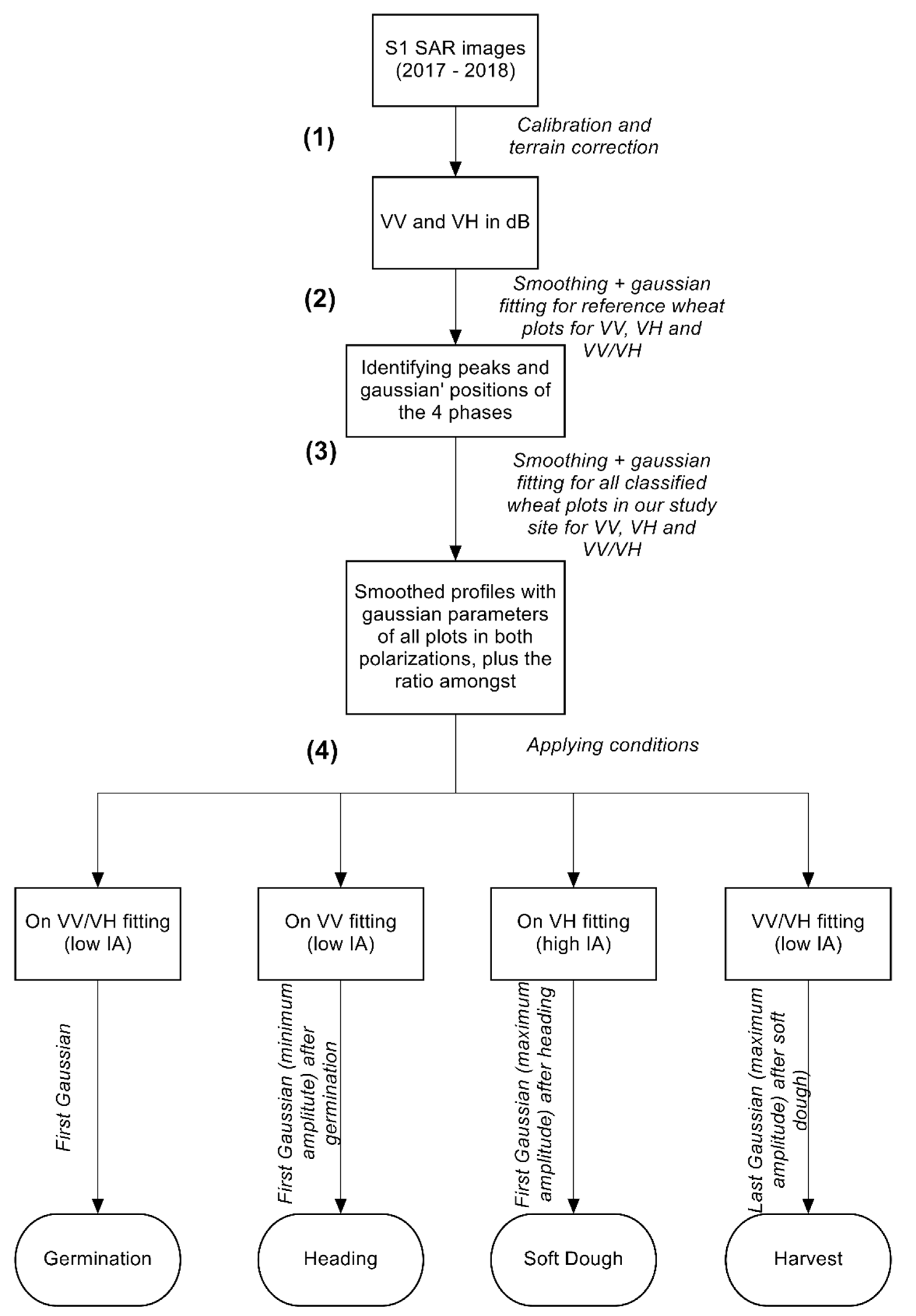
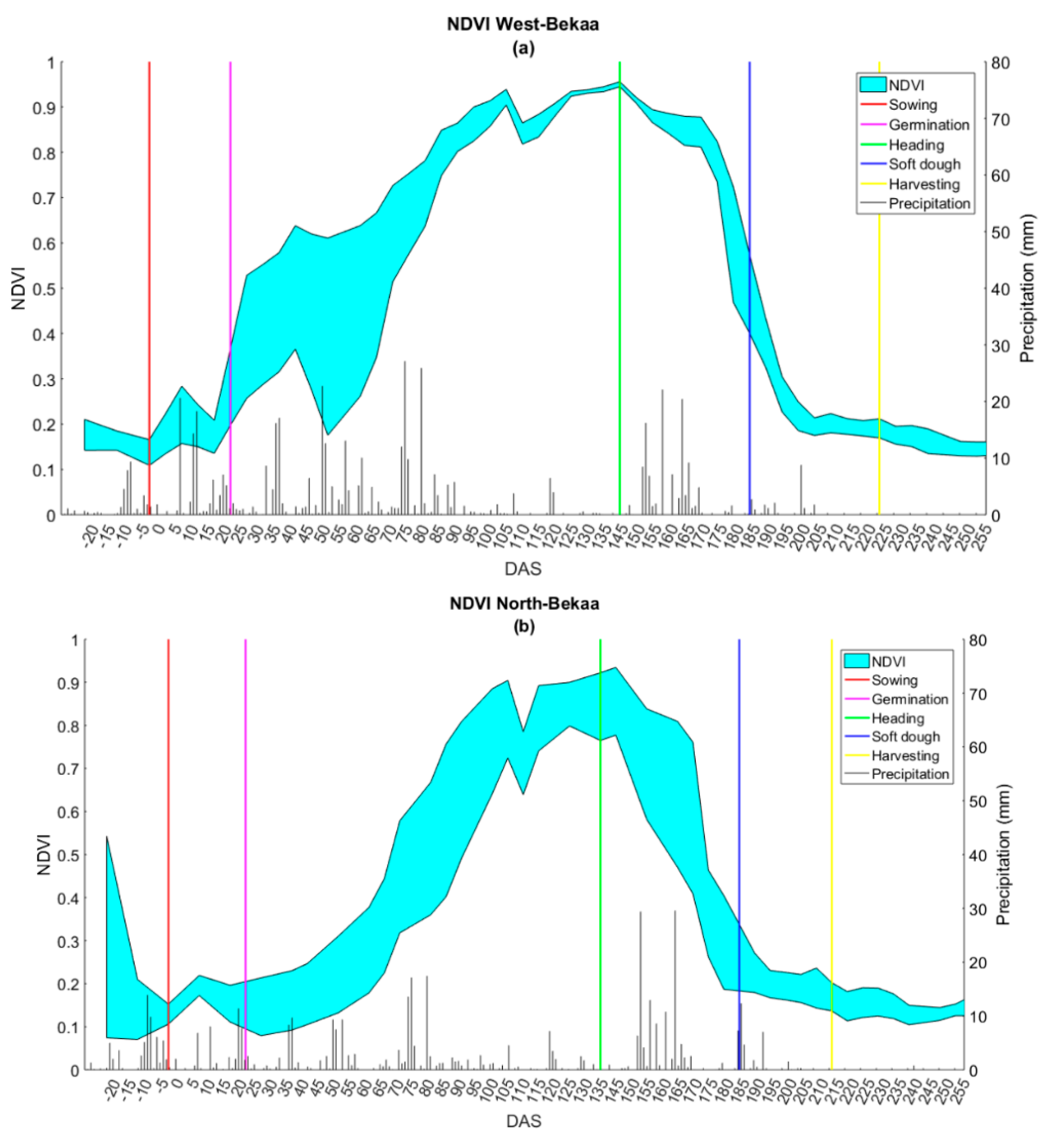
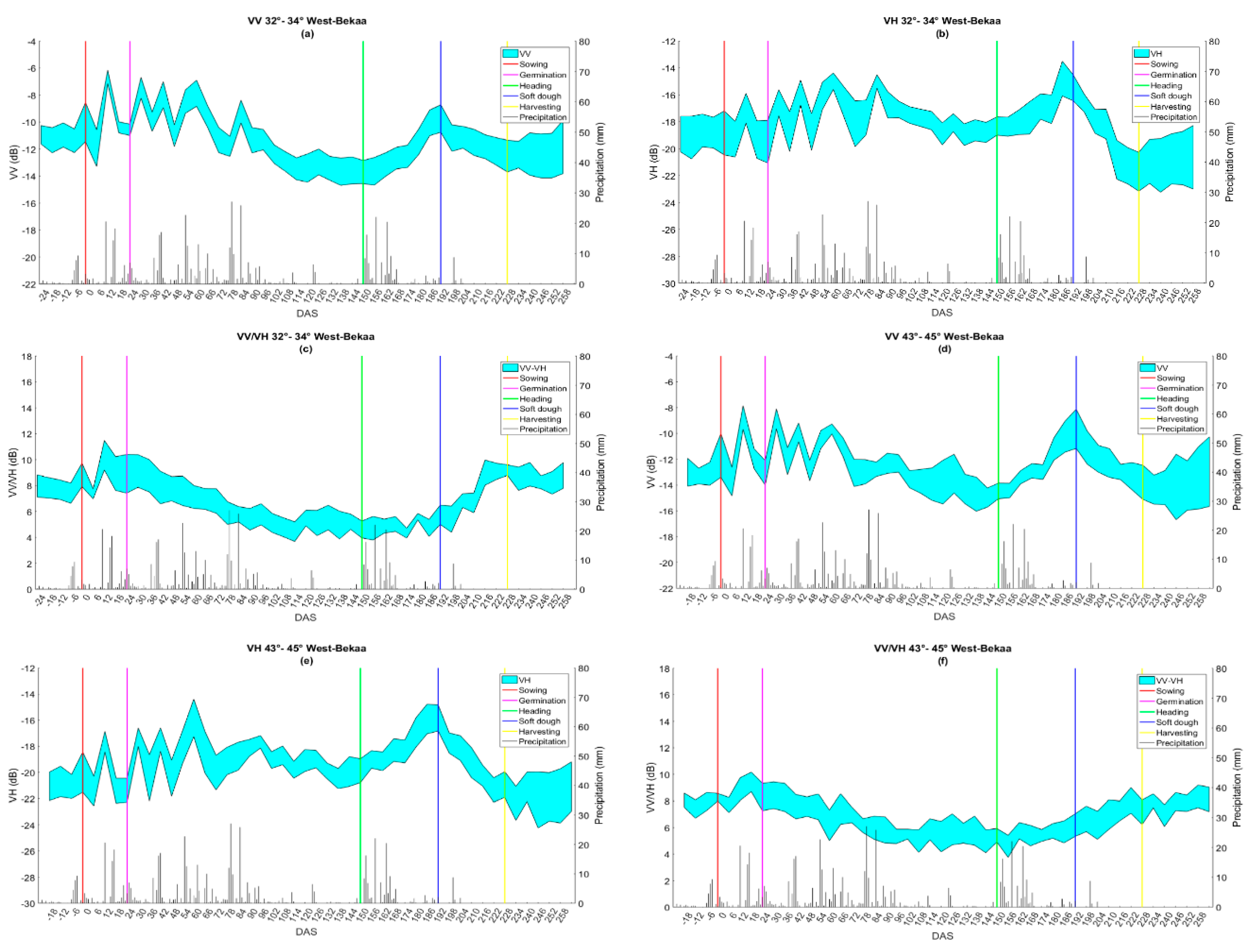
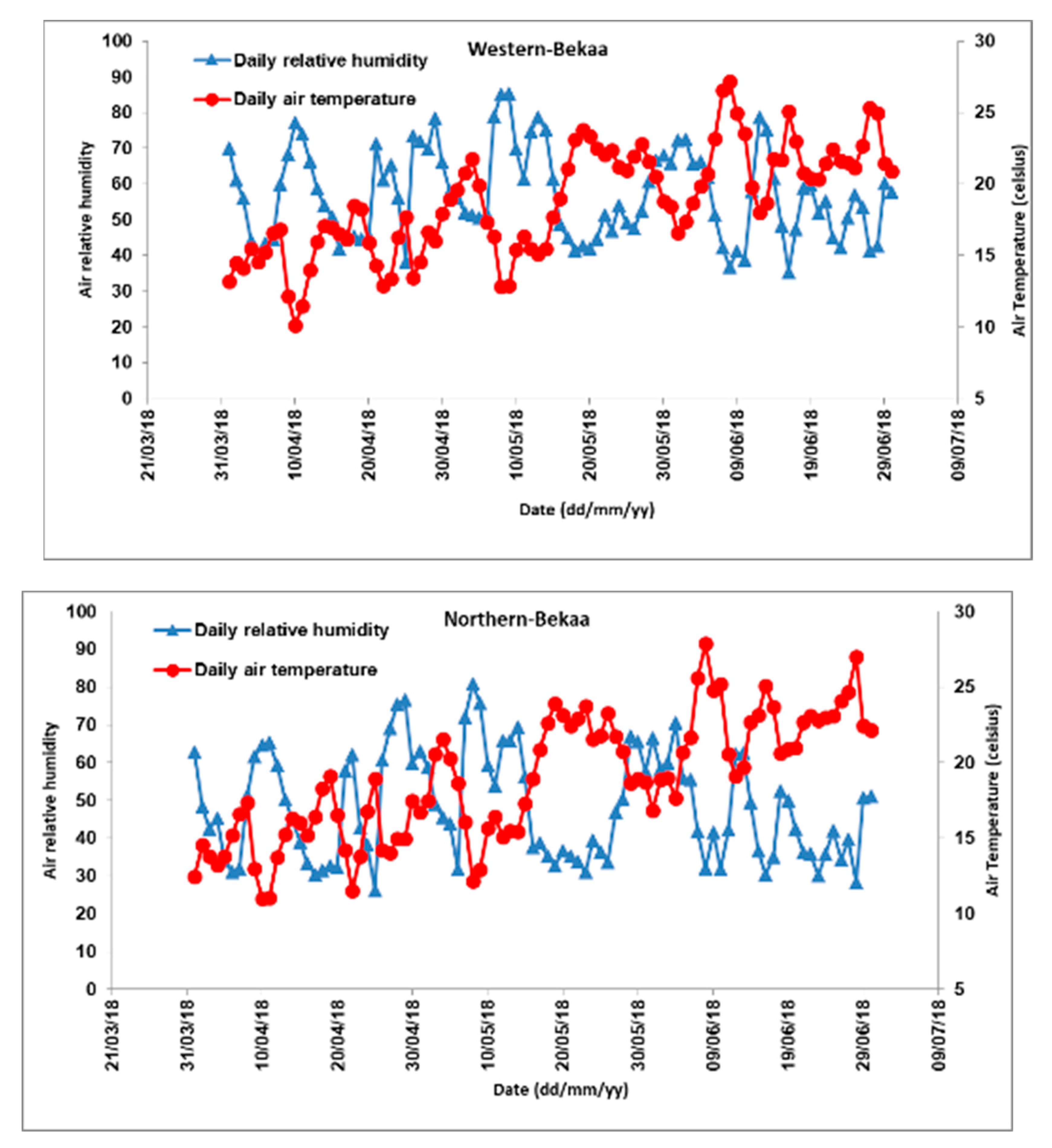
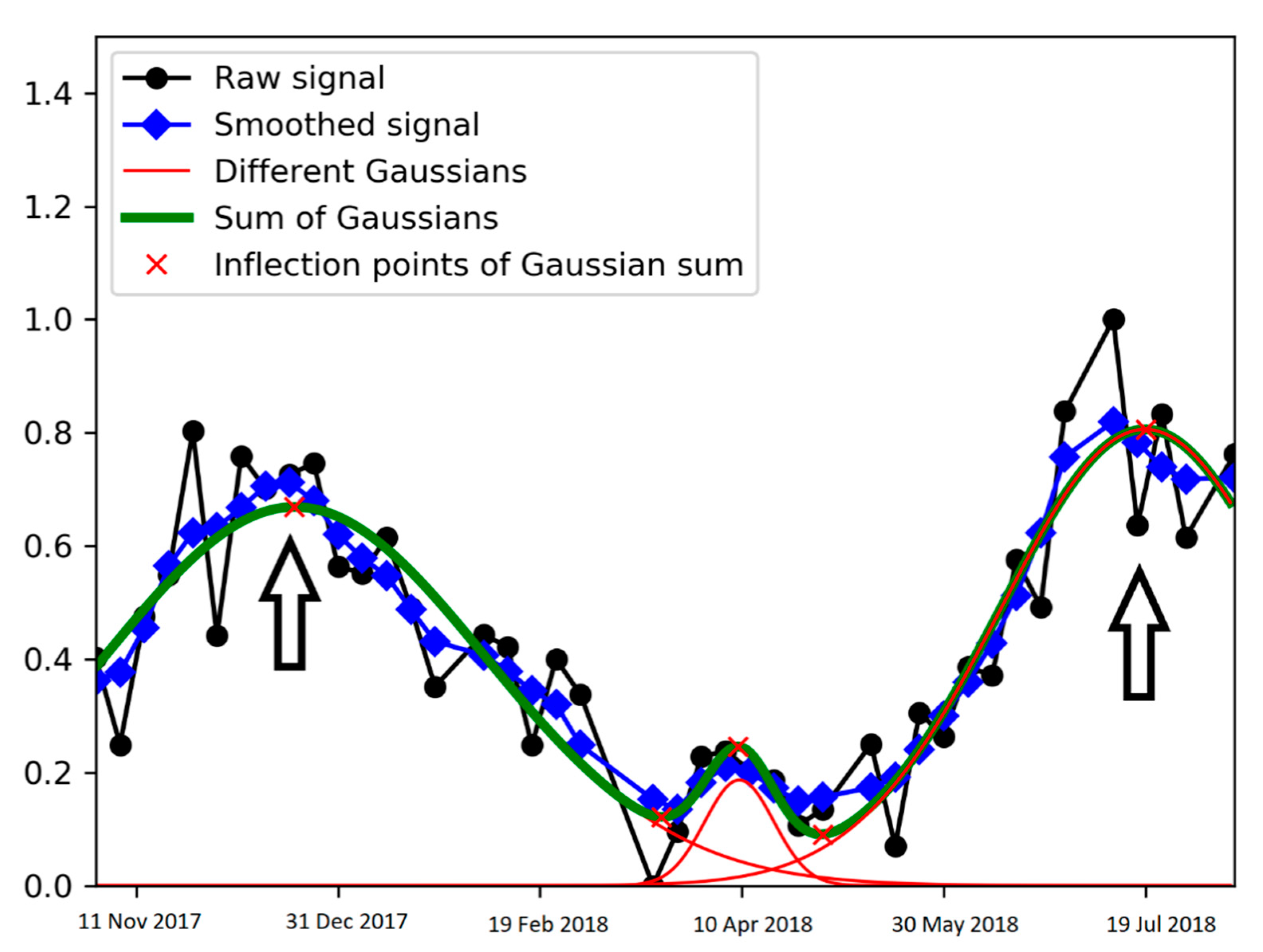
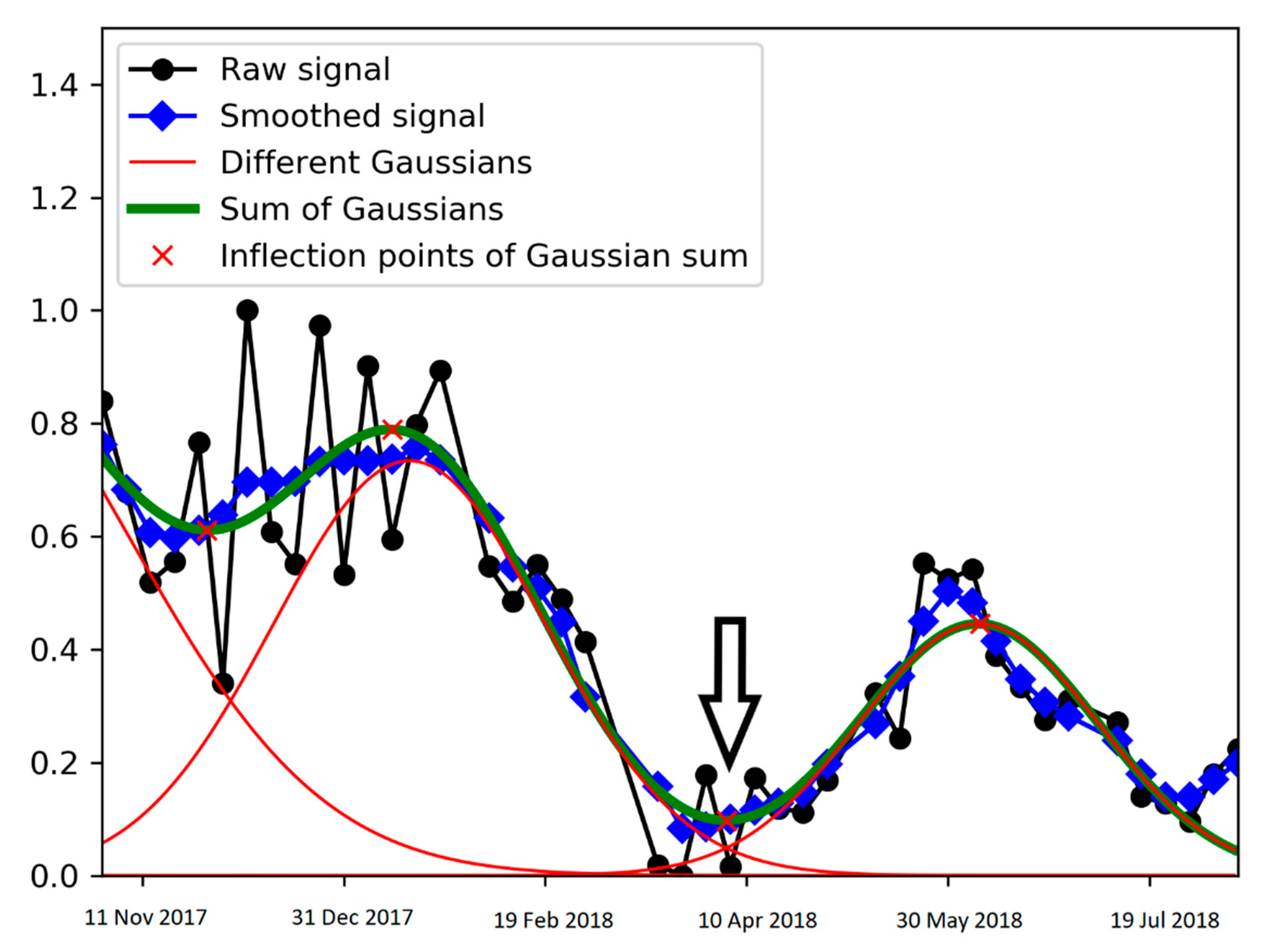
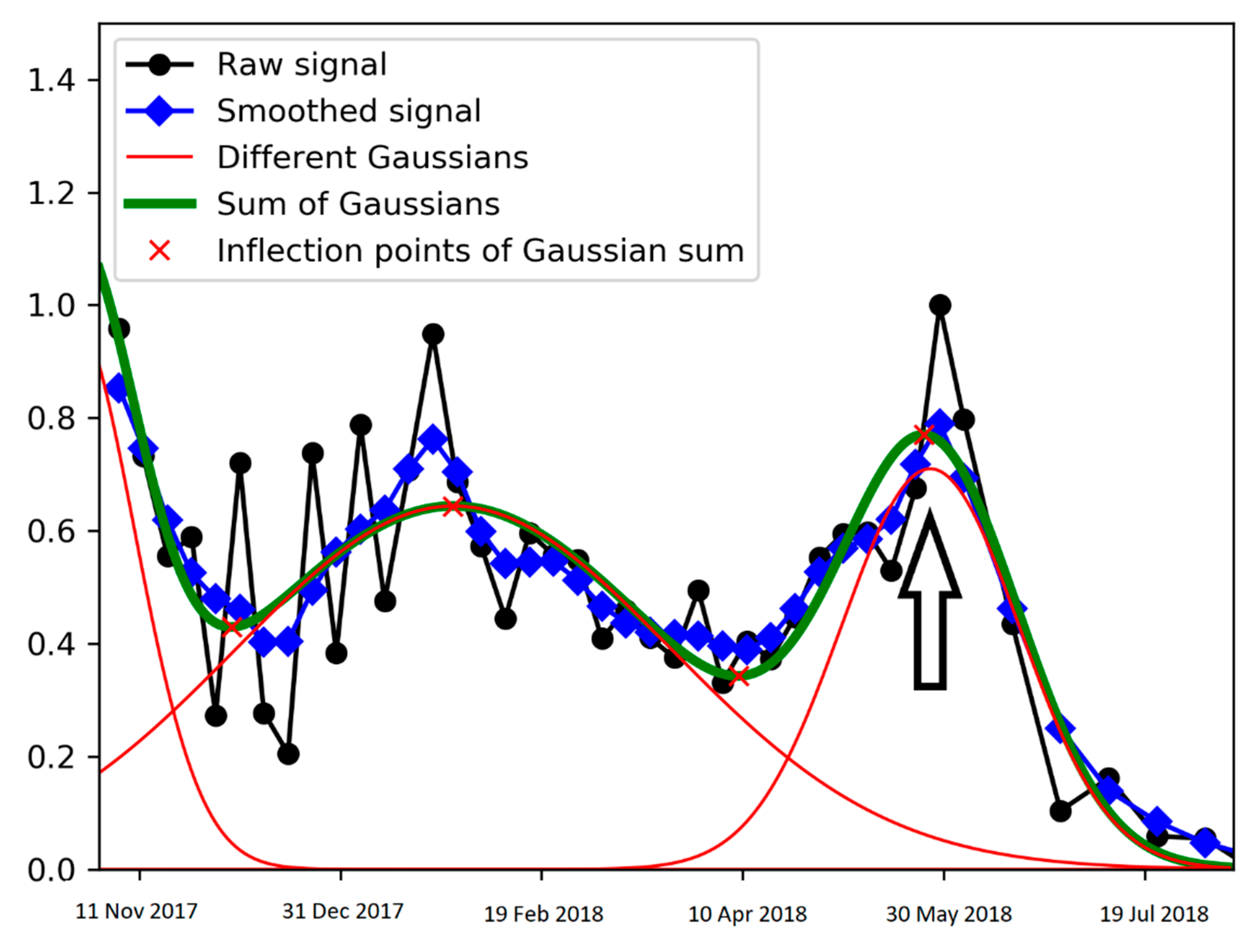
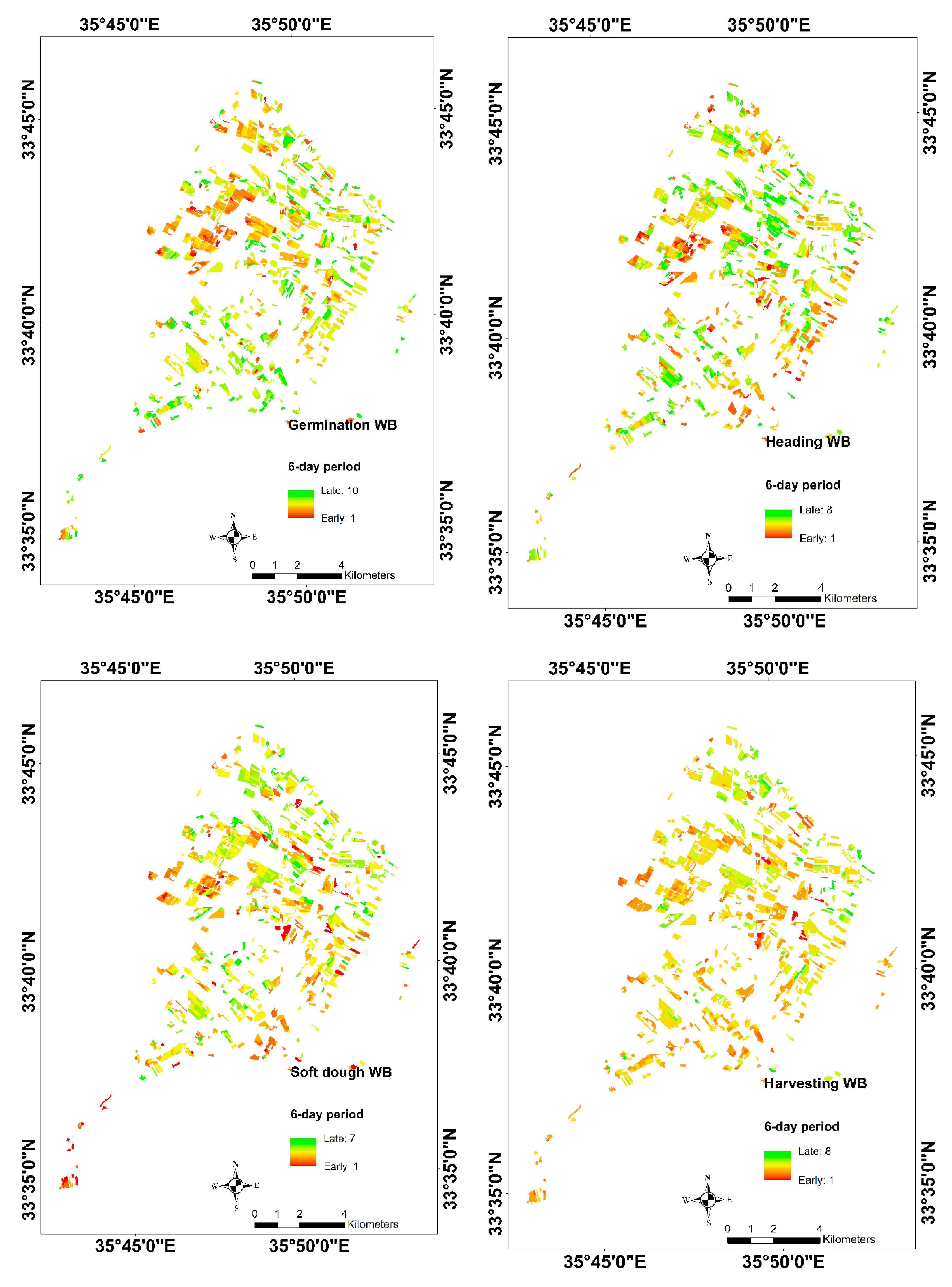

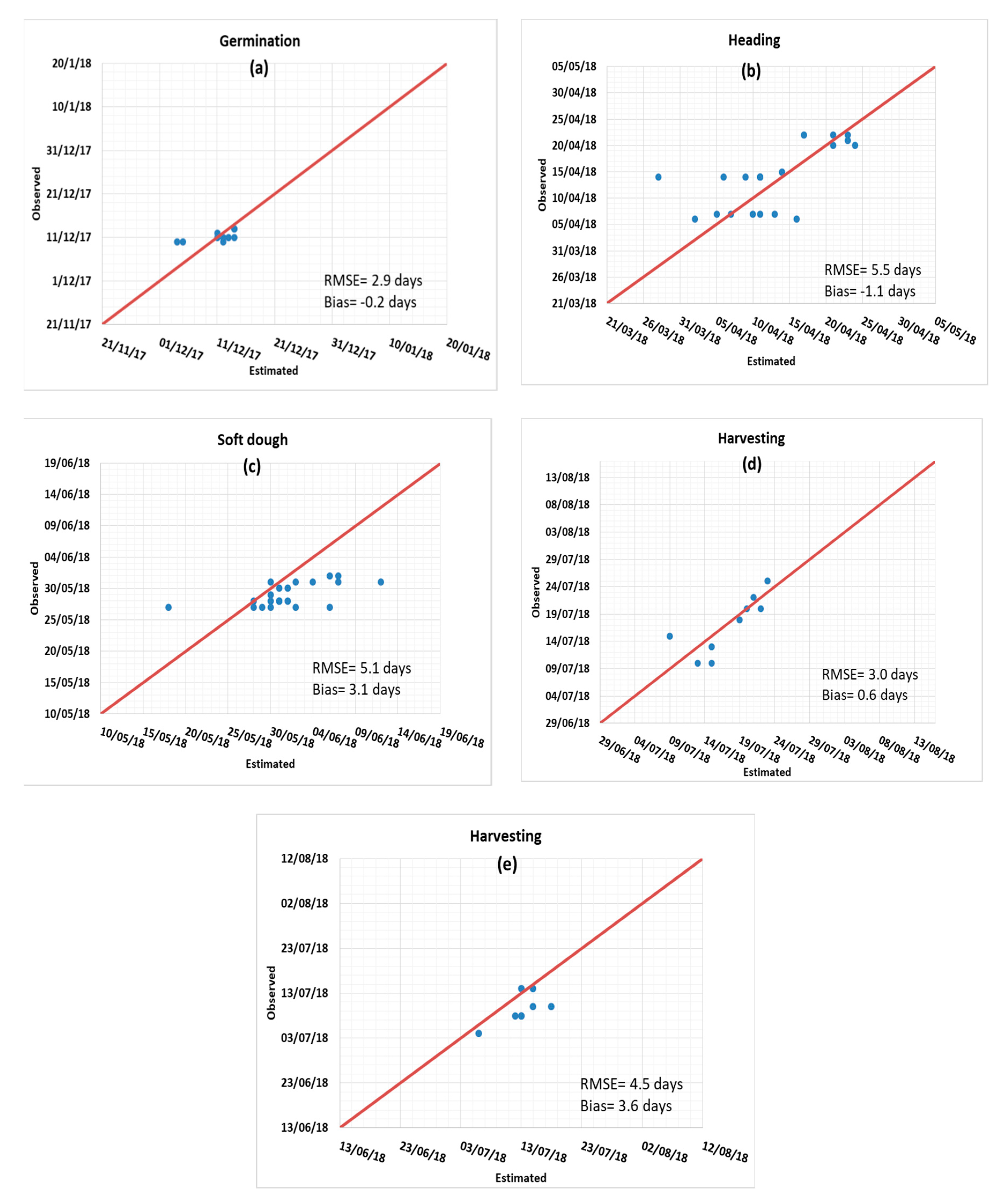
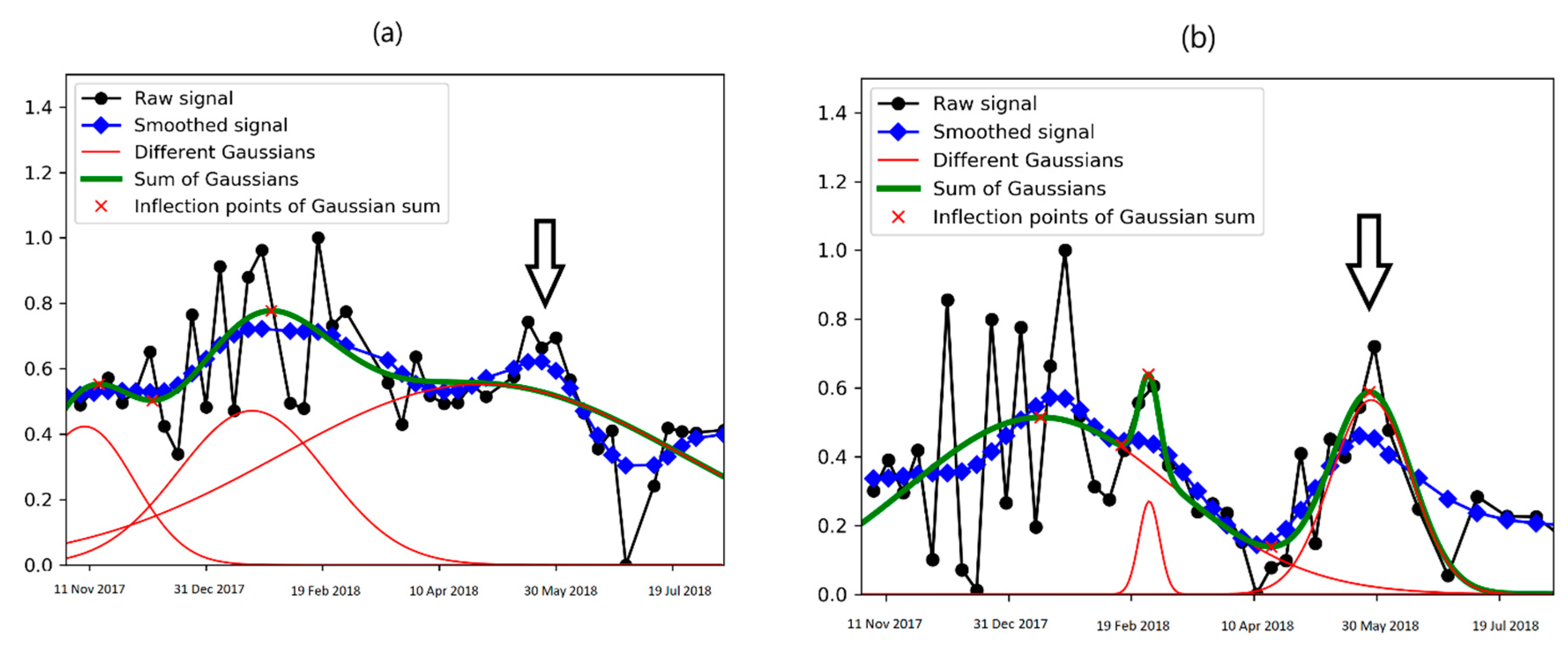
| Plot ID | Germination (Day Month Year) | Heading (Day Month Year) | Soft Dough (Day Month Year) | Harvesting (Day Month Year) |
|---|---|---|---|---|
| 1 (WB) | — | 14 April 2018 | 27 May 2018 | — |
| 2 (WB) | — | 14 April 2018 | 01 June 2018 | — |
| 3 (WB) | 10 December 2017 | 22 April 2018 | 29 May 2018 | 13 July 2018 |
| 4 (WB) | 10 December 2017 | 07 April 2018 | 01 June 2018 | 13 July 2018 |
| 5 (WB) | 11 December 2017 | 22 April 2018 | 28 May 2018 | 20 July 2018 |
| 6 (WB) | — | 07 April 2018 | 31 May 2018 | — |
| 7 (WB) | 12 December 2017 | 07 April 2018 | 27 May 2018 | — |
| 8 (WB) | 11 December 2017 | 22 April 2018 | 27 May 2018 | 22 July 2018 |
| 9 (WB) | 13 December 2017 | 21 April 2018 | 30 May 2018 | 25 July 2018 |
| 10 (WB) | — | 07 April 2018 | 27 May 2018 | — |
| 11 (WB) | — | 07 April 2018 | 27 May 2018 | 10 July 2018 |
| 12 (WB) | — | 14 April 2018 | 27 May 2018 | — |
| 13 (WB) | — | 06 April 2018 | 31 May 2018 | — |
| 14 (WB) | — | 15 April 2018 | 31 May 2018 | — |
| 15 (WB) | — | 15 April 2018 | 28 May 2018 | — |
| 16 (WB) | — | 14 April 2018 | 31 May 2018 | — |
| 17 (WB) | 11 December 2017 | 14 April 2018 | 28 May 2018 | 20 July 2018 |
| 18 (WB) | 10 December 2017 | 14 April 2018 | 31 May 2018 | 10 July 2018 |
| 19 (WB) | — | 06 April 2018 | 28 May 2018 | — |
| 20 (WB) | 13 December 2017 | 20 April 2018 | 30 May 2018 | 15 July 2018 |
| 21 (WB) | 11 December 2017 | 20 April 2018 | 28 May 2018 | 18 July 2018 |
| 1 (NB) | — | — | — | 10 July 2018 |
| 2 (NB) | — | — | — | 10 July 2018 |
| 3 (NB) | — | — | — | 04 July 2018 |
| 4 (NB) | — | — | — | 14 July 2018 |
| 5 (NB) | — | — | — | 14 July 2018 |
| 6 (NB) | — | — | — | 08 July 2018 |
| 7 (NB) | — | — | — | 08 July 2018 |
| 8 (NB) | — | — | — | 08 July 2018 |
| Germination | Heading | Soft dough | Harvesting | |
|---|---|---|---|---|
| NDVI | 0.28 ± 0.07 | 0.94 ± 0.05 | 0.48 ± 0.08 | 0.19 ± 0.01 |
| VV 32–34° | −10.58 ± −0.43 | −13.8 ± −0.75 | −9.74 ± −1.02 | −12.53 ± −1.18 |
| VH 32–34° | −19.48 ± −1.6 | −18.39 ± −0.67 | −16.0 ± −0.96 | −21.71 ± −1.44 |
| VV/VH 32–34° | 8.9 ± 1.5 | 4.64 ± 0.66 | 5.75 ± 0.75 | 9.2 ± 0.4 |
| VV 43–45° | −8.85 ± −0.75 | −14.42 ± −0.57 | −11.18 ± −1.36 | −14.35 ± −1.12 |
| VH 43–45° | −21.35 ± −0.91 | −19.87 ± −0.92 | −15.9 ± −1.09 | −22.38 ± −1.3 |
| VV/VH 43–45° | 8.43 ± 0.99 | 4.58 ± 0.83 | 6.65 ± 0.95 | 7.01 ± 0.51 |
| Phase | Polarization | Incidence Angle | Way of Determination |
|---|---|---|---|
| Germination | VV/VH | 32°–34° | First peak in the sum of Gaussians fitting (positive derivative) |
| Heading | VV | 32°–34° | First minimum after germination in the sum of Gaussians fitting (identification starts after germination date) |
| Soft dough | VH | 43°–45° | First maximum after heading in the sum of Gaussians fitting (identification starts after the heading date) |
| Harvesting | VV/VH | 32°–34° | Last maximum after soft dough in the sum of Gaussians fitting (identification starts after soft dough date) |
| Event | Corresponding Period (Day Month Year) | Percentage of Plots (%) |
|---|---|---|
| Germination (WB) | 21 November 2017–27 November 2017 | 2.0 |
| 27 November 2017–03 December 2017 | 4.7 | |
| 03 December 2017–09 December 2017 | 11.0 | |
| 09 December 2017–15 December 2017 | 14.8 | |
| 15 December 2017–21 December 2017 | 18.3 | |
| 21 December 2017–27 December 2017 | 18.0 | |
| 27 December 2017–02 January 2018 | 17.2 | |
| 02 January 2018–08 January 2018 | 8.0 | |
| 08 January 2018–14 January 2018 | 3.5 | |
| 14 January 2018–20 January 2018 | 2.5 | |
| Heading (WB) | 21 March 2018–27 March 2018 | 4.2 |
| 27 March 2018–02 April 2018 | 10.2 | |
| 02 April 2018–08 April 2018 | 16.0 | |
| 08 April 2018–14 April 2018 | 22.0 | |
| 14 April 2018–20 April 2018 | 19.1 | |
| 20 April 2018–26 April 2018 | 15.8 | |
| 26 May 2018–02 May 2018 | 10.9 | |
| 02 May 2018–04 May 2018 | 1.8 | |
| Soft dough (WB) | 10 May 2018–16 May 2018 | 6.3 |
| 16 May 2018–22 May 2018 | 13.3 | |
| 22 May 2018–28 May 2018 | 26.2 | |
| 28 May 2018–03 June 2018 | 32.0 | |
| 03 June 2018–09 June 2018 | 15.8 | |
| 09 June 2018–15 June 2018 | 5.4 | |
| 15 June 2018–18 June 2018 | 1.0 | |
| Harvesting (WB) | 14 June 2018–20 June 2018 | 0 |
| 20 June 2018–26 June 2018 | 0 | |
| 26 June 2018–02 July 2018 | 0.3 | |
| 02 July 2018–08 July 2018 | 2.5 | |
| 08 July 2018–14 July 2018 | 12.2 | |
| 14 July 2018–20 July 2018 | 27.5 | |
| 20 July 2018–26 July 2018 | 40.4 | |
| 26 July 2018–01 August 2018 | 12.1 | |
| 01 August 2018–07 August 2018 | 3.8 | |
| 07 August 2018–13 August 2018 | 0.9 | |
| 13 August 2018–16 August 2018 | 0.3 | |
| Harvesting (NB) | 14 June 2018–20 June 2018 | 0.5 |
| 20 June 2018–26 June 2018 | 1.3 | |
| 26 June 2018–02 July 2018 | 5.5 | |
| 02 July 2018–08 July 2018 | 15.6 | |
| 08 July 2018–14 July 2018 | 29.2 | |
| 14 July 2018–20 July 2018 | 28.7 | |
| 20 July 2018–26 July 2018 | 11.2 | |
| 26 July 2018–01 August 2018 | 4.5 | |
| 01 August 2018–07 August 2018 | 2.2 | |
| 07 August 2018–13 August 2018 | 1.3 | |
| 13 August 2018–16 August 2018 | 0 |
| No Image | 1 S1 Image | 2 S1 Images | 3 S1 Images | |||||||||
|---|---|---|---|---|---|---|---|---|---|---|---|---|
| Bias | RMSE (Days) | %Ref Plots | Bias | RMSE (Days) | %Ref Plots | Bias | RMSE (Days) | %Ref Plots | Bias | RMSE (Days) | %Ref Plots | |
| Germination | 14.0 | 20.8 | 80 | 12.9 | 19.1 | 80 | 13.5 | 18.6 | 80 | 7.9 | 9.6 | 100 |
| Heading | −17.4 | 19.1 | 76.2 | −13.3 | 15.3 | 81 | −8.6 | 14.7 | 81 | −4.6 | 11.1 | 81 |
| Soft dough | 5.7 | 10.9 | 85.7 | 5.9 | 10.5 | 85.7 | 3.2 | 6.1 | 100 | 3.1 | 6.1 | 100 |
| Harvesting | −10.7 | 11.7 | 60 | −8.7 | 11.3 | 70 | −3.7 | 3.9 | 70 | 1.9 | 3.9 | 70 |
© 2019 by the authors. Licensee MDPI, Basel, Switzerland. This article is an open access article distributed under the terms and conditions of the Creative Commons Attribution (CC BY) license (http://creativecommons.org/licenses/by/4.0/).
Share and Cite
Nasrallah, A.; Baghdadi, N.; El Hajj, M.; Darwish, T.; Belhouchette, H.; Faour, G.; Darwich, S.; Mhawej, M. Sentinel-1 Data for Winter Wheat Phenology Monitoring and Mapping. Remote Sens. 2019, 11, 2228. https://doi.org/10.3390/rs11192228
Nasrallah A, Baghdadi N, El Hajj M, Darwish T, Belhouchette H, Faour G, Darwich S, Mhawej M. Sentinel-1 Data for Winter Wheat Phenology Monitoring and Mapping. Remote Sensing. 2019; 11(19):2228. https://doi.org/10.3390/rs11192228
Chicago/Turabian StyleNasrallah, Ali, Nicolas Baghdadi, Mohammad El Hajj, Talal Darwish, Hatem Belhouchette, Ghaleb Faour, Salem Darwich, and Mario Mhawej. 2019. "Sentinel-1 Data for Winter Wheat Phenology Monitoring and Mapping" Remote Sensing 11, no. 19: 2228. https://doi.org/10.3390/rs11192228






